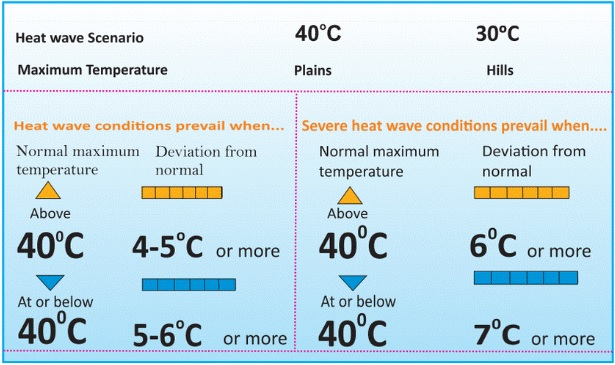Heat Waves and Heat Index | 01 Aug 2023
For Prelims: Heat Index, Heat Waves, India Meteorological Department
For Mains: Role of India Meteorological Department (IMD) in mitigating severe weather events, Concept of the Heat Index
Why in News?
India has witnessed a significant decline in heat-related deaths in recent years, reflecting the country's efforts to combat the adverse effects of heatwaves.
- The India Meteorological Department (IMD) plays a vital role in this endeavor, issuing timely forecasts and warnings to mitigate the impact of severe weather events, including heatwaves.
- Recently, IMD introduced the Heat Index, a valuable tool that considers humidity's influence on temperatures.
What are Heat Waves?
- About:
- Heat waves are prolonged periods of excessively hot weather that can cause adverse impacts on human health, the environment, and the economy.
- India, being a tropical country, is particularly vulnerable to heat waves, which have become more frequent and intense in recent years.
- IMD Criteria for Declaring Heat Wave in India:
- Heat wave is considered if the maximum temperature of a station reaches at least 40°C or more for Plains and at least 30°C or more for Hilly regions.
- Based on Departure from Normal:
- Heat Wave: Departure from normal is 4.5°C to 6.4°C.
- Severe Heat Wave: Departure from normal is >6.4°C.
- Based on Actual Maximum Temperature:
- Heat Wave: When actual maximum temperature ≥ 45°C.
- Severe Heat Wave: When actual maximum temperature ≥47°C.
- Based on Departure from Normal:
- Heat wave is considered if the maximum temperature of a station reaches at least 40°C or more for Plains and at least 30°C or more for Hilly regions.
- IMD's Initiatives and Tools to Combat Heat Waves:
- Timely issuance of heat wave forecasts to keep the public informed.
- Warnings provided to disaster management authorities for necessary preparedness.
- IMD offers Seasonal outlook and extended range forecast offering additional insights into temperature trends.
- Daily forecasts for the next five days with real-time updates.
- Color-coded warnings for severe weather events, including heat waves.
- Cooperation with National Disaster Management Authority (NDMA) and local health departments for heat action plans.
- Implementation of plans in vulnerable regions to minimize heat-related risks.
What is Heat Index?
- About:
- The Heat Index is a parameter that considers both temperature and humidity to calculate the apparent temperature or "feel like" temperature for human beings.
- It helps in understanding the impact of humidity on high temperatures and how it contributes to human discomfort during hot weather.
- The Heat Index has been launched on an experimental basis by the India Meteorological Department (IMD).
- It aims to provide general guidance for regions experiencing higher apparent temperatures causing discomfort to people.
- Indication of Heat Stress:
- High Heat Index values indicate a greater risk of heat-related stress and health issues.
- It serves as a warning for potential heat-related illnesses and dangers.
- Categorization of Heat Levels:
- The Heat Index categorizes the apparent temperature into different levels using color codes:
- Green: Experimental heat Index less than 35°C.
- Yellow: Experimental heat Index in the range 36-45°C.
- Orange: Experimental heat Index in the range 46-55°C.
- Red: Experimental heat Index greater than 55°C.
- The Heat Index categorizes the apparent temperature into different levels using color codes:
- Useful Tool for Public Health:
- By understanding the Heat Index, individuals and communities can take proactive steps to protect public health during heatwaves.
- It assists in making informed decisions and formulating heat action plans to ensure the well-being of the population.
UPSC Civil Services Examination, Previous Year Question (PYQ)
Prelims
Q. What are the possible limitations of India in mitigating global warming at present and in the immediate future? (2010)
- Appropriate alternate technologies are not sufficiently available.
- India cannot invest huge funds in research and development.
- Many developed countries have already set up their polluting industries in India.
Which of the statements given above is/are correct?
(a) 1 and 2 only
(b) 2 only
(c) 1 and 3 only
(d) 1, 2 and 3
Ans: (a)
Mains
Q. Bring out the causes for the formation of heat islands in the urban habitat of the world. (2013)

